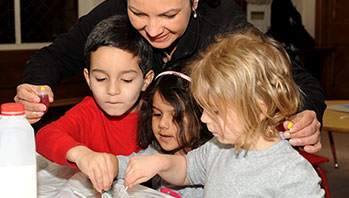- recycled food trays and containers
- plastic plates
- paper clips
- craft sticks
- sponges
- aluminum foil
- pennies
- sticky notes
- marker
- chart paper
- paper towels (for spills)
- camera or cellphone with camera
- boat
- float
- sink
MA Standards:
Mathematics/Counting and Cardinality/PK.CC.MA.4: Count many kinds of concrete objects and actions up to ten, using one-to-one correspondence, and accurately count as many as seven things in a scattered configuration.
Mathematics/Counting and Cardinality/PK.CC.MA.5: Use comparative language, such as more/less, equal to, to compare and describe collections of objects.
Mathematics/Measurement and Data/PK.MD.MA.2: Compare the attributes of length and weight for two objects, including longer/shorter, same length; heavier/lighter, same weight; holds more/less, holds the same amount.
Head Start Outcomes:
Logic and Reasoning/Reasoning and Problem Solving: Classifies, compares, and contrasts objects, events, and experiences.
Science Knowledge/Scientific Skills and Method: Observes and discusses common properties, differences, and comparisons among objects.
Science Knowledge/Scientific Skills and Method: Collects, describes, and records information through discussions, drawings, maps, and charts.
PreK Learning Guidelines:
English Language Arts/Language 2: Participate actively in discussions, listen to the ideas of others, and ask and answer relevant questions.
Mathematics/Number Sense 2: Connect many kinds/quantities of concrete objects and actions to numbers.
Small Group: Sink the Boat

© Commonwealth of Massachusetts, Department of Early Education and Care (Jennifer Waddell photographer). All rights reserved.
STEM Key Concepts: Objects behave differently in water; Some things float; Some things sink; If you add enough weight to a floating object, it will sometimes sink; Solids have physical characteristics that can be observed and described
ELA Focus Skills: Listening and Speaking, Predicting, Vocabulary
Invite children to choose a boat. Tell children you want them to determine how many pennies their boat can hold before it sinks to the bottom. Have children take turns placing pennies on the boat one at a time. Encourage another child to make a dot on the paper each time she or he places a penny on the boat.
When the boat sinks, have children count how many pennies were on the boat before it sank. Have them record the number on a sticky note and place it on the boat. Then have them empty the pennies out of the boat. Tell them to take one penny out of the pile. Say, Now let’s place the pennies on the boat one at a time and whether it will still float if we put the same number of pennies in it as we did before it sank. Once you have determine how many the boat will hold twice, repeat the process until all boats have been explored.
Once children have determined how many pennies each boat will hold and still float, have them present their boat and tell how many pennies it could hold. Ask children to share their ideas about why some boats held more pennies than others.
- What was the most any boat could hold? The least?
